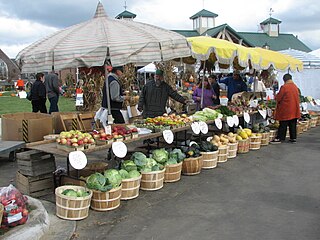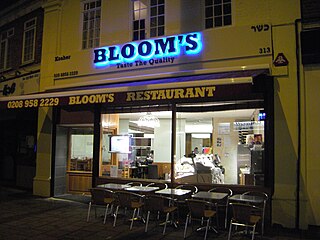A preservative is a substance or a chemical that is added to products such as food products, beverages, pharmaceutical drugs, paints, biological samples, cosmetics, wood, and many other products to prevent decomposition by microbial growth or by undesirable chemical changes. In general, preservation is implemented in two modes, chemical and physical. Chemical preservation entails adding chemical compounds to the product. Physical preservation entails processes such as refrigeration or drying. Preservative food additives reduce the risk of foodborne infections, decrease microbial spoilage, and preserve fresh attributes and nutritional quality. Some physical techniques for food preservation include dehydration, UV-C radiation, freeze-drying, and refrigeration. Chemical preservation and physical preservation techniques are sometimes combined.

Smoked salmon is a preparation of salmon, typically a fillet that has been cured and hot or cold smoked.

Biltong is a form of dried, cured meat which originated in Southern African countries. Various types of meat are used to produce it, ranging from beef to game meats such as ostrich or kudu. The cut may also vary being either fillets of meat cut into strips following the grain of the muscle, or flat pieces sliced across the grain. It is related to beef jerky; both are spiced, dried meats; however the typical ingredients, taste, and production processes may differ.

Food storage is a way of decreasing the variability of the food supply in the face of natural, inevitable variability. It allows food to be eaten for some time after harvest rather than solely immediately. It is both a traditional domestic skill and, in the form of food logistics, an important industrial and commercial activity. Food preservation, storage, and transport, including timely delivery to consumers, are important to food security, especially for the majority of people throughout the world who rely on others to produce their food.

A farmers' market is a physical retail marketplace intended to sell foods directly by farmers to consumers. Farmers' markets may be indoors or outdoors and typically consist of booths, tables or stands where farmers sell their produce, live animals and plants, and sometimes prepared foods and beverages. Farmers' markets exist in many countries worldwide and reflect the local culture and economy. The size of the market may be just a few stalls or it may be as large as several city blocks. Due to their nature, they tend to be less rigidly regulated than retail produce shops.
Agribusiness is the industry, enterprises, and the field of study of value chains in agriculture and in the bio-economy, in which case it is also called bio-business or bio-enterprise. The primary goal of agribusiness is to maximize profit while satisfying the needs of consumers for products related to natural resources such as biotechnology, farms, food, forestry, fisheries, fuel, and fiber.

Liquid smoke is a water-soluble yellow to red liquid used as a flavoring as a substitute for cooking with wood smoke while retaining a similar flavor. It can be used to flavor any meat or vegetable. It is available as pure condensed smoke from various types of wood, and as derivative formulas containing additives.

The Center for Science in the Public Interest (CSPI) is a Washington, D.C.-based non-profit watchdog and consumer advocacy group that advocates for safer and healthier foods.
Serbian cuisine is a Balkan cuisine that consists of the culinary methods and traditions of Serbia. Its roots lie in Serbian history, including centuries of cultural contact and influence with the Greeks and the Byzantine Empire, the Ottomans, and Serbia's Balkan neighbours, especially during the existence of Yugoslavia. Historically, Serbian food develops from pastoral customs that involved the keeping of sheep in mountain highlands, in a climate and regional context that favoured animal husbandry over vegetable farming; Serbian food is therefore traditionally richer in animal products and basic grains—corn, wheat and oats—than fresh vegetable dishes. Following the abandonment of widely practiced pastoral lifestyles, Serbian food emerged through the Middle Ages heavily dependent not on lamb or mutton, but on the keeping of pigs for the annual cull and the production of various cured meats, such as sausages, bacon and ham products.

Mister Donut is an international chain of doughnut stores. It was founded in the United States in 1956 by Harry Winokur. Primary offerings include doughnuts, coffee, muffins and pastries. After being acquired by Allied Domecq in 1990, most of the North American stores became Dunkin' Donuts. Outside of the United States, Mister Donut maintains a presence in Japan, El Salvador, Philippines, Thailand, Indonesia, Taiwan, and Singapore.

Morinda is a multi-level marketing company based in American Fork, Utah that sells Tahitian Noni juice and other products made from the noni plant. The company was founded in 1996 and has manufacturing facilities in Tahiti, Japan, China, Germany, and Utah. Morinda, formerly known as Tahitian Noni International and Morinda Bioactives, was a subsidiary of Morinda Holdings, Inc. prior to merging with and becoming a wholly owned subsidiary of New Age Beverages Corporation in December 2019.

Food policy is the area of public policy concerning how food is produced, processed, distributed, purchased, or provided. Food policies are designed to influence the operation of the food and agriculture system balanced with ensuring human health needs. This often includes decision-making around production and processing techniques, marketing, availability, utilization, and consumption of food, in the interest of meeting or furthering social objectives. Food policy can be promulgated on any level, from local to global, and by a government agency, business, or organization. Food policymakers engage in activities such as regulation of food-related industries, establishing eligibility standards for food assistance programs for the poor, ensuring safety of the food supply, food labeling, and even the qualifications of a product to be considered organic.

A breakfast sandwich is any sandwich filled with foods associated with breakfast. Breakfast sandwiches are served at fast food restaurants and delicatessens, sold in supermarkets, or commonly made at home. Different types of breakfast sandwich include the bacon sandwich, the egg sandwich, and the sausage sandwich; or various combinations thereof, like the bacon, egg and cheese sandwich. The breakfast sandwich is related to the breakfast roll.

A kosher restaurant or kosher deli is an establishment that serves food that complies with Jewish dietary laws (kashrut). These businesses, which also include diners, cafés, pizzerias, fast food, and cafeterias, and are frequently in listings together with kosher bakeries, butchers, caterers, and other similar places, differ from kosher-style businesses in that they operate under rabbinical supervision, which requires that the laws of kashrut, as well as certain other Jewish laws, including the separation of meat and dairy must be observed.

The Food Safety Modernization Act (FSMA) was signed into law by President Barack Obama on January 4, 2011. The FSMA has given the Food and Drug Administration (FDA) new authority to regulate the way foods are grown, harvested and processed. The law grants the FDA a number of new powers, including mandatory recall authority, which the agency has sought for many years. The FSMA requires the FDA to undertake more than a dozen rulemakings and issue at least 10 guidance documents, as well as a host of reports, plans, strategies, standards, notices, and other tasks.

Vacchiano Farm is a winery in the Port Colden section of Washington Township in Warren County, New Jersey, United States. A family produce and livestock farm since 1983, the vineyard was first planted in 2004, and began to sell its wine in 2009. Vacchiano has 11 acres of grapes under cultivation, and produces 2,500 cases of wine per year.

Food safety in the United States relates to the processing, packaging, and storage of food in a way that prevents food-borne illness within the United States. The beginning of regulation on food safety in the United States started in the early 1900s, when several outbreaks sparked the need for litigation managing food in the food industry. Over the next few decades, the United States created several government agencies in an effort to better understand contaminants in food and to regulate these impurities. Many laws regarding food safety in the United States have been created and amended since the beginning of the 1900s. Food makers and their products are inspected and regulated by the Food and Drug Administration and the Department of Agriculture.

Ashkenazi Jewish cuisine is an assortment of cooking traditions that was developed by the Ashkenazi Jews of Central, Eastern and Northern Europe, and their descendants, particularly in the United States and other Western countries.














